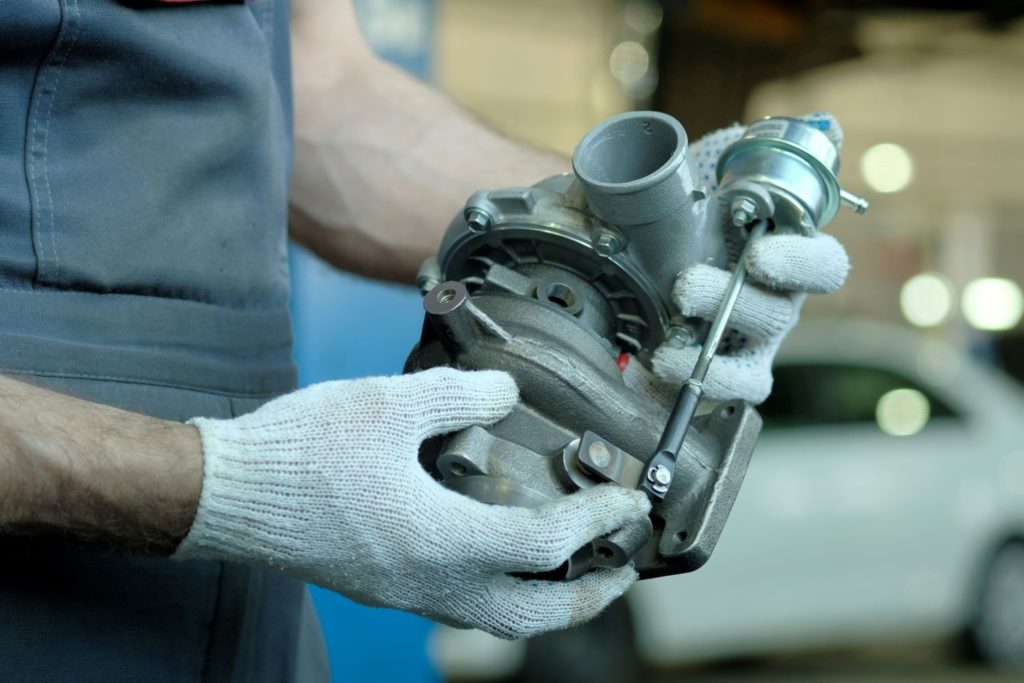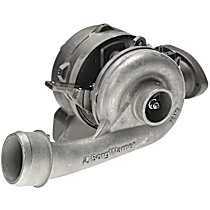You might’ve heard the term “turbo” before but had no idea what they look like. In this article, we’ll discuss what turbochargers are, what they look like, how they work, and whether or not they’re beneficial for your vehicle.
What Is a Turbocharger?
A turbocharger is a device that’s designed to improve the overall efficiency and performance of internal combustion engines. A compressor and a turbine make up the two halves of a turbocharger. The former is attached to the air intake, while the latter is attached to the engine’s exhaust manifold. Both halves are connected by a shaft.
The turbocharger was invented by Swiss engineer Alfred Büchi in 1905. He was looking for ways to make combustion engines more efficient. After several failed attempts, Büchi succeeded in building the world’s first turbocharger. This device reduced a vehicle’s emissions and fuel consumption while increasing its engine power. Büchi’s turbocharger paved the way for future innovations in engine performance and efficiency.

How Do Turbochargers Work?
Turbochargers use forced induction to push more air into the engine’s cylinders to get more power. The process starts when hot exhaust gases enter the turbocharger’s turbine. The gas pressure spins the turbine wheel that’s connected to the compressor wheel on the other side of the turbo. The turbine wheel spins in tandem with the compressor wheel, sucking in outside air through the compressor side’s inlet port.
The air is compressed and passed to the outlet port by the spinning compressor wheel. The compressed air passes through a pipe to the intercooler, where it’s cooled before being fed into the engine through the intake manifold. As a result, the engine receives more power and better fuel economy without being overworked. A turbocharger delivers more air to your engine than a standard air intake system, resulting in a boost.
Aside from the turbocharger itself, there are three other primary components in a turbocharging system. These are the following:

Intercooler
The intercooler is located between the turbo and the engine. This part is responsible for cooling compressed air before it enters the engine. The cooler air is denser and helps the engine to make more power.
Wastegate
The wastegate is a valve that regulates boost pressure by controlling exhaust flow to the turbine wheel. It prevents the turbine wheel from spinning too fast and protects the turbocharger and engine from damage.
Relief Valve
Turbocharged engines have a relief valve (also known as a compressor bypass valve). When the throttle is closed rapidly, the relief valve quietly prevents excess pressure from building up and traveling back to the turbo’s compressor.
PCM
On modern vehicles the powertrain control module (PCM) is responsible for controlling the turbocharger’s wastegate, usually via a boost control solenoid. The PCM also typically controls the relief valve.

The Pros and Cons of Turbochargers
Turbochargers, like everything else, have a few tradeoffs. Here are some of the pros and cons of turbochargers.
Pros
A turbocharger can improve horsepower and torque in diesel and gas engines. The standard turbocharger can give a vehicle’s engine around 20 to 40 percent more power depending on the turbocharger’s size, engine modifications, and the fuel used.
Cons
A turbocharger forces the engine to work harder, which can result in wear and tear. Adding an aftermarket turbocharger to a vehicle can also be expensive.
Best Turbocharger Brands
The right turbocharger can make all the difference. Check out these turbocharger brands and push your engine to the limit.
Borgwarner
Borgwarner produces turbochargers for major downstream customers like Alfa Romeo, Audi, Bentley, BMW, Peugeot, Nissan, Ford, and many others. The electronic turbocharger is one of its newest products. This turbocharger improves turbine response at low speeds.
Mitsubishi
Mitsubishi Heavy Industries (MHI) is one of the world’s most renowned turbocharger manufacturers. Its downstream customers include BMW, Subaru, and Mitsubishi. Mitsubishi’s superchargers are available in a variety of configurations, such as the exhaust booster, variable cross-section, and twin vortex tubes. Its passenger car turbochargers are smaller than those produced by Garett and Borgwarner.
Mahle
Bosch Mahle Turbo Systems has established itself as a major turbocharger manufacturer. It has five factories worldwide and develops turbochargers for both passenger and commercial vehicles. Volkswagen is Mahle’s biggest downstream customer.
Replacement
Replacement turbochargers are praised for their superb build quality and performance. They’re affordable, long-lasting, and compatible with a wide range of vehicles.
How Much Do Turbochargers Cost?
An aftermarket turbocharger costs anywhere between $200 and $2500 depending on the brand, series, and location. You can expect to pay around $200 on labor costs to install a low-end turbocharger. Meanwhile, premium turbocharger upgrades can cost up to $4,000 for installation.
Any information provided on this Website is for informational purposes only and is not intended to replace consultation with a professional mechanic. The accuracy and timeliness of the information may change from the time of publication.


 Borgwarner
Borgwarner
 Mahle
Mahle
 Mitsubishi
Mitsubishi
 Replacement
Replacement



























